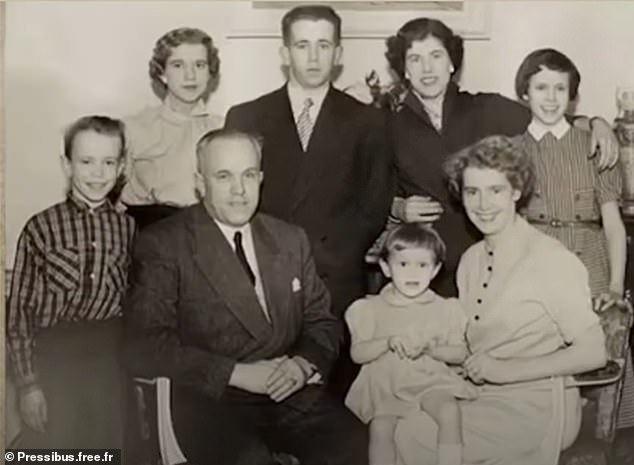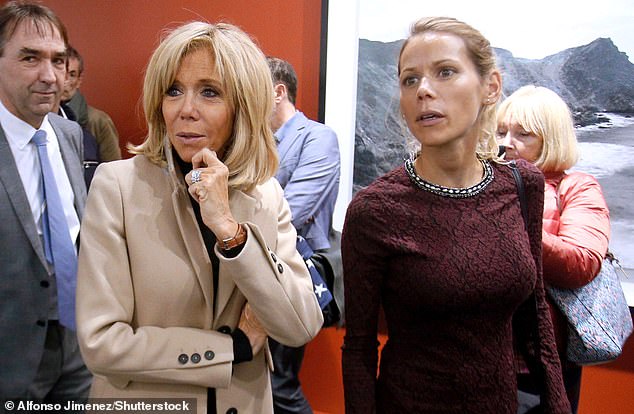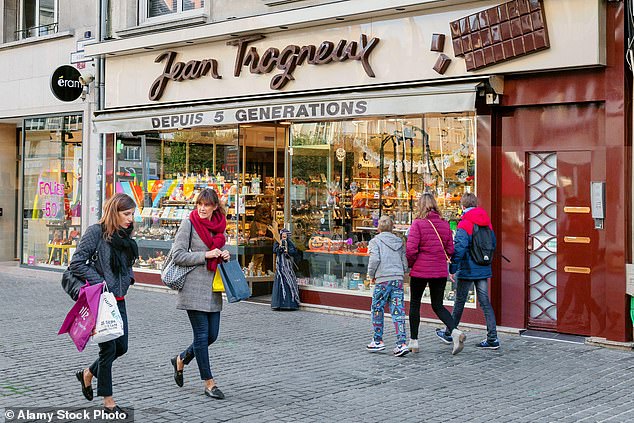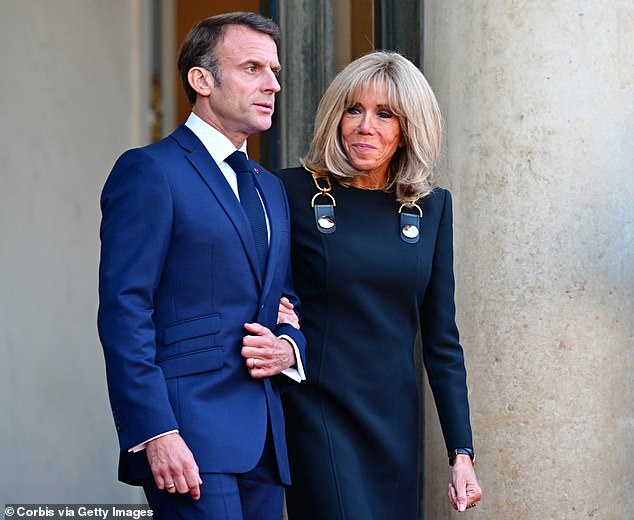The cute little girl with a pudding bowl hairstyle sitting on her mother’s knee is Brigitte Trogneux. Her family are renowned chocolatiers and pastry chefs in the Amiens region of northern France, where the exclusive Trogneux brand is as well known as Thorntons is in the UK.
But the family – or rather the young person in the photograph – has another, much greater claim to fame today.
She grew up to be Brigitte Macron, First Lady of France, wife of President Emmanuel Macron. Trogneux is her maiden name.
The black and white family portrait, featuring her parents and siblings, was taken back in the 1950s.
Could anyone, least of all Brigitte herself, have imagined that more than half a century would be spent on a smear campaign by the far right, who falsely claimed she was born a man.

The little girl with a pudding bowl hairstyle sitting on her mother’s knee is Brigitte Trogneux and on the far left is her brother Jean-Michel
Last year, Brigitte won a libel case against the freelance journalist who made the first claim, but still, it’s a vicious and unfounded rumor that hasn’t completely disappeared from parts of social media.
Most recently, Brigitte’s daughter Tiphaine Auziere, a lawyer, has spoken about the impact of the charges.
In an interview earlier this month to mark the publication of a novel she has written, Tiphaine, 40, told Paris Match: ‘I am concerned at the level of society when I hear what is circulating on social networks that my mother is a man.
“The confidence with which it is said and the credibility given to it is proclaimed. How can we resist disinformation on social networks?’
Macron himself, speaking on International Women’s Day last week after the publication of the interview, expressed his anger and frustration at the rumors and their impact on their private lives.
“The worst is the false information and made-up scenarios,” he said. ‘People eventually believe them and disturb you, even in your intimacy.’
The claim initially went unnoticed when a small far-right monthly publication called Faits et Documents (Facts and Documents) went to press with the results of a so-called ‘three-year investigation’ of Mrs Macron, now 70, in September 2021.
But when ‘correspondent’ Natasha Rey – who contributes to the magazine and has a history of attacking the Macrons on Facebook – gave an interview on YouTube that year, the allegations went viral online.
In the interview she referred to the old Trogneux family photograph. The little girl sitting on her mother’s knee, she claimed, was probably Nathalie Farcy, who was orphaned when Brigitte’s older sister, Maryvonne, was killed in a car accident with her husband, Paul Farcy, when Brigitte was very young.
And Brigitte? Her birth name, she claimed, was Jean-Michel Trogneux – the boy in the checkered shirt in the photograph – before ‘he’ became a transgender woman and underwent gender reassignment surgery in the early 1980s.
You couldn’t make that up, could you?
Almost immediately, the ‘story’ began to circulate widely on social media.
Websites associated with the far right, antivaxxers, the Yellow Vests (‘Gilets Jaunes’) anti-government movement and QAnon extremists, who believe the US is in the grip of devil-worshiping child abusers, are spreading the false claims.
The attack on Ms Macron led to fears of the “Trumpisation” of the political debate in France, with fake news being used to potentially influence voters, particularly by the far right in the 2022 presidential election, which Macron went on to win. .


Brigitte Macron with her daughter Tiphaine Auziere, who has spoken out about her mother’s story in a recent Paris Match interview


Brigitte’s family are renowned chocolatiers and pastry chefs in the Amiens region of northern France, where the exclusive Trogneux brand is as well known as Thorntons is in the UK
The ‘trigger’ for the pseudo-investigation in Faits et Documents – ‘The Mystery of Brigitte Macron’ – was ‘physics’, according to Ms Rey, who claimed that ‘experts’, including cosmetic surgeons ‘all agree with me that ( Brigitte Macron) is transsexual’.
Ridiculous, perhaps, but a 2021 YouGov survey found that a higher proportion of French and Americans were likely to believe in conspiracy theories (38 and 33 per cent respectively) than their British counterparts (19 per cent).
The dirty tricks campaign against the Macrons illustrates how easily fiction can seemingly become reality with just a few clicks and a hashtag in today’s world.
Our own research suggests that the ‘boy in the checkered shirt’ may be her late older brother Jean-Claude. He was eight years older than Brigitte and became manager of the family’s chocolate factory.
Birth certificates in France, unlike the UK, can only be obtained from the person whose name appears on the certificate or a relative of that person.
But Brigitte Macron’s arrival in the world was announced in Courrier Picard, the daily newspaper of the Picardy region, where Amiens, her hometown, is the capital, which records her birth on April 13, 1953.
Referring to Brigitte’s three sisters and two brothers, it reads: ‘Anne-Marie, Jean-Claude, Maryvonne, Monique and Jean-Michel Trogneux are delighted to announce the arrival of their little sister, Brigitte.’
Faits et Documents magazine says Elysee officials ‘had been unable to provide a photograph of Brigitte as a child’.


Brigitte entered the Elysee Palace in 2017 as the wife of the youngest president in French history – she was 64, Emmanuel was 39
We found several in reputable French publications, including a seven-year-old Brigitte taking her first communion, not to mention one of her playing in the garden of her home, as well as all in white on her wedding day, with her first (late ) husband, wealthy banker Andre-Louis Auziere.
Before entering the Elysee Palace in 2017 as the wife of the youngest president in French history – she was 64, he was 39 – Mrs Macron, a former teacher, told her pupils: ‘You will hear remarks, true and false. I never want to talk about them.’
However, Brigitte made an exception in this case. Natasha Rey, 48, and Amandine Roy, a 52-year-old clairvoyant who appeared on the four-hour YouTube video in December 2021, were found guilty of libel and initially fined the equivalent of £1,700 each, reduced on appeal to £ 850 for Roy and £400 for Rey.
But beyond the evil rumours, the story of Brigitte Macron is fascinating in itself, and not without scandal.
She first met Emmanuel Macron in September 1992. She was 39, a married mother of three and a teacher at the French Catholic school in Amiens. He was 15 and a student in the same class as one of her daughters.
Their 24-year age difference still draws gasps, except in France, where the attractiveness of the older woman has long been celebrated.
Ms Macron, who has been compared to Brigitte Bardot and Catherine Deneuve, regularly graces the cover of Paris Match and other celebrity magazines. So much for being ‘born man’.
Throughout their 16-year marriage, she has played a key role in his political career, ‘somewhere between spin doctor and eminence grise’, to quote one commentator.
But back in Amiens, their growing friendship all those years ago caused outrage locally.
Brigitte’s family ran the confectionery shop on Place Notre Dame in the center of the city, now the flagship branch of the Trogneux chain, which has 12 other branches in northern France.
Their specialty was macarons, sweets made from almonds, honey and egg whites.
Her father was a pillar of respectability, a regular churchgoer and member of the Rotary Club.
Brigitte attended the Sacred Heart convent school; everyone knew her since she was a child and watched her grow up as the youngest of six siblings.
Her family called her the ‘happy little princess’. “It suited her perfectly – she was a lovely little girl who was always the center of attention,” said a family friend.
Another resident of Amiens, who knows the family well, added: ‘She always got wonderful presents and was treated like a princess. She was a real little girl who liked to dress up and wear her mother’s jewelry.
“She used to get silver bracelets and the like from her parents. When she passed her exams, they got her a moped.’
At 21, on a trip to the seaside resort of Le Touquet, where her family had a summer house, she met Andre-Louis Auziere, who was born in Cameroon, where his father worked as a diplomat.
At 23, he was two years older than Brigitte, who was still a student, and had embarked on what turned out to be a successful career in banking.
They were duly married at the local town hall in 1974, the same year Emmanuel Macron’s parents got married.
When Brigitte was 26, two girls and a boy had arrived.
Despite these easily checked, verifiable facts, Faits et Documents magazine continued with its skewed ‘she was born a man’ narrative.
What no one disputes is that Brigitte would eventually get a teaching position at the Lycee La Providence Catholic school in Amiens.
One of the classes she taught was drama. The star pupil was Emmanuel Macron, whose mother and father were doctors.
Both parents were horrified by the rumors that they were having an affair. The teenager Emmanuel was sent to Paris to complete his education. But their relationship continued long distance for 13 years and the rest, as they say, is history.
“There are times in your life when you need to make important choices,” Mrs Macron would explain in an interview many years later.
‘And for me that was it. What has been said over the last 20 years is insignificant. Of course we eat breakfast together, me and my wrinkles, him with his youth, but that’s how it is.’
There were no public sightings of Brigitte’s first husband after she left him in 1996, and he died in December 2019, aged 66.
Their son Sebastien Auziere – who, at 48, is only two years older than his stepfather Macron – has worked for the president as a statistician.
Their eldest daughter Laurence, 46, was in the same class as Emmanuel at the school in Amiens where Brigitte was a teacher.
Younger daughter Tiphaine has publicly supported the relationship. “If I have to give a vision of love, it’s Emmanuel and mother,” she said in a 2018 interview.
And in her recent interview with Paris Match, she said of the furore it caused in their small town: ‘I learned a lot about human nature.
‘I know that in these moments we must focus on the essentials and move forward without taking criticism into account.
‘The attacks, the slander, the judgments. It was not yet the era of social networks, but we were in a small provincial town. Everything is known.
“Despite all this, they stood tall. I gained an open mind, the desire to move forward without listening to peripheral noise and gained greater tolerance.’
